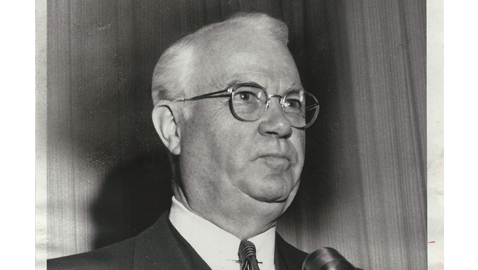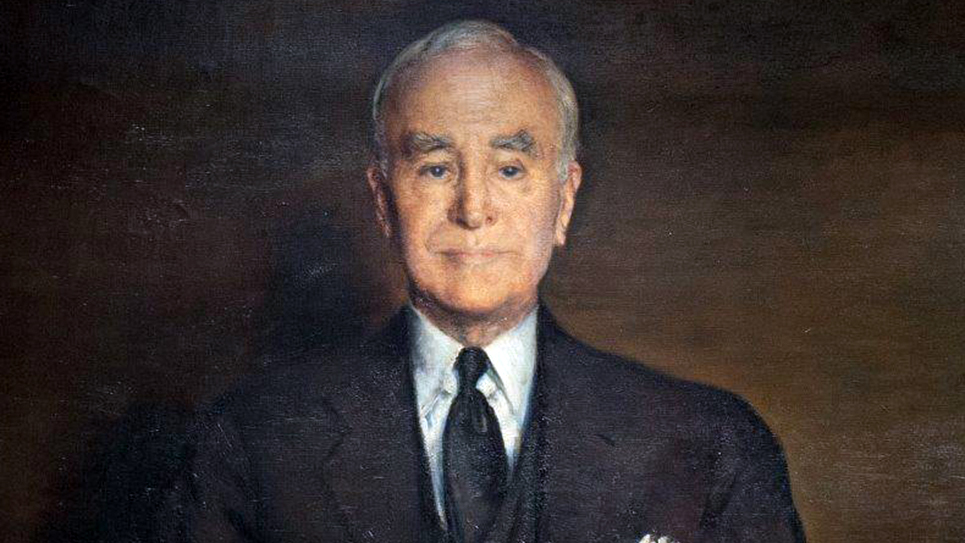Few politicians have a career as successful as that of John William Bricker of Ohio; state attorney general (an elected position in Ohio), three times governor and twice United States senator.
Bricker came from very humble beginnings, born on September 6, 1893, along with a twin sister, in Madison County, Ohio. Handsome and athletic, John Bricker was quite popular in high school, but concentrated on his studies and his first love, baseball. Bricker went on to Ohio State University where he participated in the debate team when not playing varsity baseball. Bricker was good enough to attract offers to play semi-professional baseball, but opted instead to study law. John Bricker’s legal studies were interrupted by the World War. Bricker desperately tried to enlist, but was rejected for service due to a heart murmur. Undaunted, John Bricker tried to enlist in every branch of the service and was rejected by each in turn. Frustrated, Bricker finally managed to get himself admitted in the Chaplain’s service with the condition he could not preach, but the war ended before he could be sent overseas. Bricker returned to his studies and began practicing law in Columbus, Ohio in 1920.
By 1923, John W. Bricker had been hired as an assistant state attorney general, traveling the length and breadth of Ohio trying cases. Quite likable, personable, and friendly, John Bricker made friends everywhere he went. Bricker was a member of the Ohio Public Service Commission from 1929 – 1932. John W. Bricker picked one of the worst years in history to make his electoral debut. He ran for state attorney general in 1932, a year when Republicans were being blamed for the Great Depression. Franklin D. Roosevelt and the Democrats swept across the nation like a tidal wave. John W. Bricker was the only Republican to win a statewide office in Ohio that year.
In 1936, Bricker was the logical and most popular candidate available to the GOP to run for governor of Ohio. If anything, 1936 was a worse year for Republicans than 1932 had been and Bricker lost, albeit narrowly. Bricker never stopped campaigning and ran again in 1938. Incumbent governor Martin Davey had become a highly controversial figure and his administration was bedeviled by scandal and corruption. Davey lost the Democratic primary to businessman Charles Sawyer, who lost to Bricker.
1938 was a good year for Republicans in Ohio; not only had John W. Bricker been elected governor, but Robert A. Taft, son of the late president and Chief Justice of the U. S. Supreme Court, William Howard Taft, had ousted an incumbent Democrat from the United States Senate.
Governor Bricker immediately set out to balance Ohio’s fiscal house. When he came into office, Ohio was afloat in red ink; by the time he left office, Ohio had a surplus of some $70 million (almost a billion dollars in today’s currency). Bricker’s budget cutting was not universally popular and the governor was challenged in 1940 by his predecessor, Martin Davey. Once again, Bricker was the beneficiary not only of his own personal popularity, but a brutal fight inside the Democratic Party. Two former governors fought bitterly over the nomination. Martin Davey and George White battered one another mercilessly, a fight which Davey ultimately won, but it was a pyrrhic victory, as he lost the general election badly to Governor Bricker.
Bricker sought a third two-year term in 1942 and faced Democrat John Sweeney, who lost by almost 400,000 votes.
In 1944, Bricker was interested in seeking the Republican nomination for the presidency. He was hardly the only Ohioan with presidential ambitions. Bob Taft had been in the Senate only two years when he sought the GOP nomination in 1940, but the senator was up for reelection that year, a campaign he would win only narrowly. Bricker’s chief opponent for the GOP nomination was a fellow governor, Thomas E. Dewey of New York. Dewey was as imperious and cold personally as Bricker was friendly and down-to-earth. The New Yorker had pledged when first elected governor in 1942 that he would serve out his term and ran an aggressive non-campaign for the Republican presidential nomination. The 1940 GOP candidate Wendell Willkie wanted another chance and entered the Wisconsin primary and made an intensive speaking tour of the state. His hopes were shattered when he lost badly to non-candidate Dewey. By the time the GOP convention convened in Chicago, John W. Bricker was the chief opposition to the man the tart-tongued Alice Roosevelt Longworth once dismissed as looking like the little man on the wedding cake. Governor Bricker soon concluded he did not have enough delegate strength to beat Dewey for the nomination and withdrew before the balloting. When Bricker made his speech before the convention, the delegates rose in tribute and many observers felt it was the only heartfelt demonstration of the entire convention, far more tumultuous than that given Governor Dewey.
Thomas Dewey had wanted California governor Earl Warren as his running mate, but the Californian refused. Dewey tapped Bricker as his running mate and the two waged a game campaign against Franklin Roosevelt and Harry Truman. The Republicans lost, but the Dewey – Bricker ticket made the best showing of any Republican duo since FDR had first been elected in 1932. The GOP carried Ohio, while Dewey lost his home state to Roosevelt (it was FDR’s home state as well). Dewey and Bricker had made a race of it and when he knew he had won, President Roosevelt had been resentful of Dewey, grumbling, “I still think he’s a son-of-a-bitch.”
Bricker returned to Columbus and formed Bricker and Eckler, one of the most successful law firms in Ohio and the Midwest. Yet, politics was still much on his mind and he was the strongest candidate the Republicans could field against Senator James W. Huffman in 1946. Huffman had been appointed to the U. S. Senate when Harold H. Burton, a Republican, had been appointed to the U. S. Supreme Court by President Truman in 1945.
Huffman was the son-in-law of popular former governor and U. S. senator Vic Donahey, but had lost the Democratic primary in his lone statewide campaign. Senator Huffman was no match for the popular Bricker.
John W. Bricker overwhelmed Senator Huffman, winning 57% of the vote in a big Republican year.
Just months after coming to Washington, Bricker experienced the most harrowing episode of his political life. While walking in the underground tunnels connecting the Senate Office Building to the Capitol, a deranged man who was a former policeman at the Capitol and somehow blamed Bricker for his financial losses, fired off several shots at the senator. Bricker had the presence of mind to duck into one of the Senate subway cars and was whisked away while the gunman was disarmed and arrested.
Bricker joined Robert Taft in the United States Senate. Senator Bricker would aid his colleague’s presidential aspirations in the 1948 and 1952 Republican conventions. It was Bricker who would appear before the delegates to assuage hurt feelings and move the choice of the convention be made unanimous in Taft’s losing bids. The 1952 convention was especially sad for many, as everyone knew it was the last presidential campaign Bob Taft would wage. A year later, Taft would be dead.
Following the death of Robert A. Taft in 1953, John Bricker became the premier Republican officeholder in the State of Ohio. The two men had been completely different, both in physical appearance, style, and substance. Taft’s personality was in marked contrast to that of John W. Bricker. Taft was austere and frequently off-putting, while Bricker was accessible and personable. Both were conservative, but Bob Taft was recognized for his intellect, while Bricker was oftentimes derided for being anything but intellectual. Taft was somewhat dumpy and balding, while Bricker was tall, handsome and possessed a head of hair that began to turn white. John Bricker looked like a statesman.
Handily reelected in 1952 while Taft’s brother, Charles, was losing the gubernatorial election, John W. Bricker would finally serve with a Republican president with the election of Dwight D. Eisenhower. Yet, Bricker’s relations with Eisenhower would not be what either man hoped they would be. If he is remembered today, it is for the proposed amendment to the U. S. Constitution that bears his name: the Bricker Amendment.
Senator John W. Bricker introduced an amendment, in essence, that would have restricted executive authority in making treaties and issuing executive agreements made by the president. Not surprisingly, President Eisenhower was profoundly opposed to the adoption of the Bricker Amendment.
Senator Bricker’s amendment had the strong support of most of his own party and not a few Democrats. The Eisenhower administration had to use every resource at its disposal to fight off the Bricker Amendment. President Eisenhower was caught in a difficult position, as his own State Department was fiercely opposed to the concept of the Bricker Amendment, while most Republican senators supported the idea. In fact, as originally proposed, Bricker’s amendment had broad bipartisan support in the United States Senate.
President Eisenhower was forced to look to Senate Democrats to block the passage of the Bricker Amendment. He found a willing ally in the most powerful Democrat inside the Senate, one with presidential ambitions of his own: Lyndon B. Johnson of Texas. Author Robert Caro, the best of Lyndon Johnson’s many biographers, wrote, “Defeating the amendment and thereby preserving the power of the presidency – – – his first objective (Eisenhower’s) – – – could not be accomplished even if he united his party’s liberal and moderate senators against it; there simply were not enough of them.”
Eisenhower argued the Bricker Amendment would fatally dilute the power of the president to make American foreign policy. Senators tried to reach a compromise with language that would appease both President Eisenhower and Senator Bricker. It was an impossible task. Lyndon Johnson nudged perhaps the most respected Democrat in the Senate, Walter F. George of Georgia, to introduce a substitute intended to kill Bricker’s proposal. Senator Bricker was livid, knowing full well that Walter George also supported the idea of limiting presidential treaty making powers.
With his usual political shrewdness, LBJ had picked the perfect opponent to stall John Bricker’s proposal. George had survived a purge attempt to remove him from the Senate by no less than Franklin Roosevelt; George had also served as the highly respected Chairman of the Senate’s Finance and Foreign Relations Committees. George was also the most senior member of the Senate at the time and was revered by many of the Senate’s members.
President Eisenhower tried to prevent a vote on the Bricker Amendment, as both sides knew it would be close. Nobody was better at counting votes than the wily Texan and LBJ held several cards up his well-tailored sleeve. To pass, the Bricker Amendment needed two-thirds approval and when the vote finally came, it lost by a single vote. LBJ had summoned the mortally ill Harley M. Kilgore of West Virginia to the Senate Chamber to cast the deciding vote.
It was the greatest disappointment of John W. Bricker’s political life. Toward the end of his long life, Bricker snapped, “Ike did it! He killed my amendment.”
While certainly a conservative, Bricker was viewed by many as an ultra-conservative following his spat with Eisenhower. Senator Bricker ran for a third term in 1958 and was expected to win easily, especially as his opponent was sixty-nine year old Stephen Young, who despite having been elected to Congress several times was considered to be something of a perennial candidate for public office. Bricker likely would have survived an election that saw the Republicans lose thirteen seats in the United States Senate had not his supporters insisted upon placing a Right-To-Work referendum on the ballot in Ohio. The unions came to life and energized members who may very well not have voted otherwise. Bricker, recognizing the danger, begged his friends not to place the referendum on the ballot. His pleas fell on deaf years and he lost narrowly.
Bricker returned to Columbus with his wife, Harriet, and resumed his law practice. The former senator enjoyed a leisurely life with an excellent income and he spent a great deal of time in his magnificent library at his home. He and Harriet were especially close and together they had adopted a son, Jack.
John Bricker continued to be a presence inside Ohio’s Republican Party. Despite his seventy-one years, many urged him to run for the Senate again in 1964, but Bricker decided against it. When President Ronald Reagan came to Ohio to campaign for reelection in 1984, ninety-year old John W. Bricker sat on the platform. His beloved Harriet died and Bricker’s health began to deteriorate. Bricker’s son moved him to an assisted living facility where friends and former employees would visit the former senator. Bricker enjoyed sitting outside his room to smoke an occasional cigar and chat.
Turned down for military service during World War I, John William Bricker died on March 22, 1986 at age ninety-two.







